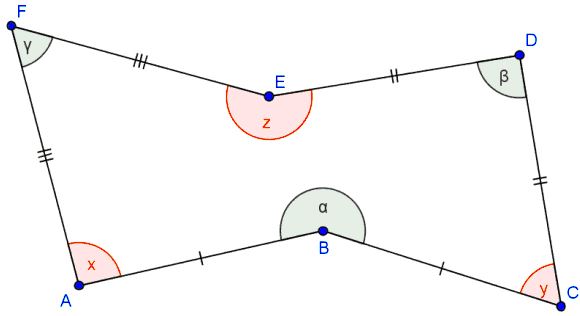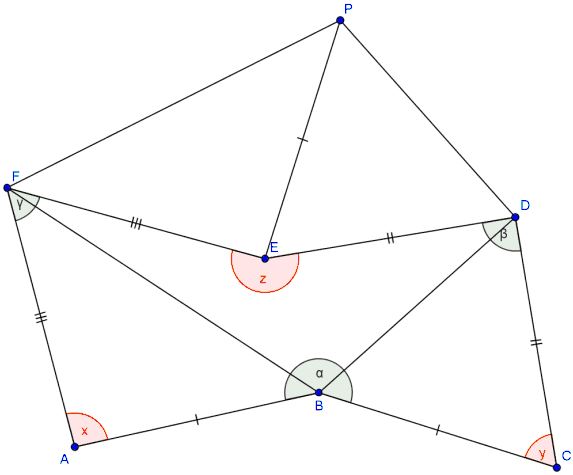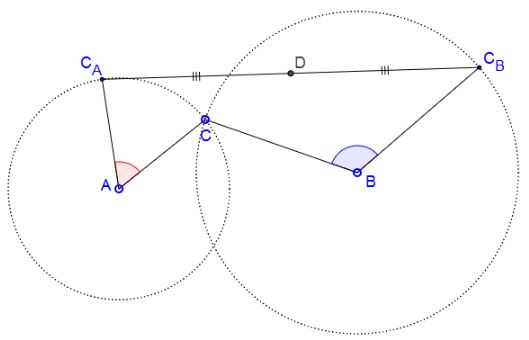Bottema in Three Rotations
Wojtek Wawrów
27 May, 2014
The following theorem and proof can be found in Waldermar Pompe's booklet Wokół obrotów (Theorem 3.5), and can be thought as of a generalization of a generalization of Bottema's theorem:
Given hexagon $ABCDEF$ (not necessarily convex) in which $AB=BC,$ $DC=DE,$ $FE=FA,$ let $\alpha,$ $\beta,$ $\gamma$ denote the internal angles of this hexagon at the vertices $B,$ $D,$ $F,$ respectively. Assume $\alpha +\beta +\gamma=360^{\circ}.$

Then at vertices $B,$ $D,$ $F,$ $\Delta BDF$ has angles $\displaystyle\frac{\alpha}{2},$ $\displaystyle\frac{\beta}{2},$ $\displaystyle\frac{\gamma}{2},$ respectively.
Proof
Let us also denote the other internal angles of hexagon as above. Note that because $\alpha +\beta +\gamma=360^{\circ}$ we also have $x+y+z=360^{\circ}.$ Thus there are two possibilities: either none exactly one of angles $x,y,z$ is at least $180^{\circ}.$ Without loss of generality assume $z\ge 180^{\circ}$ ((if none of the angles is concave, the argument won't change). Rotate $\Delta BCD$ around $D$ through angle $\beta$ so that point $C$ moves to point $E.$ Let $P$ be the image of point $B$ under this rotation. We can easily verify that $\angle PEF=x$ (because $\angle PED=y$ and $x+y+z=360^{\circ}.$Since we also have $PE=BC=AB$ and $EF=AF,$ we get $\Delta FAB=\Delta FEB.$ So, if we rotate $\Delta FAB$ around $F$ through angle $\gamma,$ we will get triangle $\Delta FEP.$
It follows that $BD=DP,$ $BF=PF,$ $\angle BDP=\beta,$ $\angle BFP=\gamma.$

Since $DBFP$ is a kite, diagonal $DF$ bisects two of its angles, giving us $\displaystyle\angle BDF=\frac{\beta}{2}$ and $\displaystyle\angle BFD=\frac{\gamma}{2}.$ That $\displaystyle\angle DFB=\frac{\alpha}{2}$ follows from $\alpha +\beta +\gamma=360^{\circ}.$
Now, how can this extend the generalization of Bottema's theorem? We'll show how this implies the generalized Bottema: apply above theorem to the hexagon $C_{B}DC_{A}ACB.$

Because $\angle C_{B}DC_{A}=180^{\circ},$ $\angle C_{A}AC+\angle CBC_{B}=180^{\circ}$ and $C_{B}D=DC_{A},$ $C_{A}A=AC,$ $CB=BC_{B},$ this is exactly the setup of the above theorem. So we instantly get $\displaystyle\angle ADB=\frac{180^{\circ}}{2}=90^{\circ}.$ We also get that angles $DAB$ and $DBA$ do not depend on point $C$ (because angles $CAC_A$ and $CBC_B$ don't depend on it) so the angles of $\Delta ABD$ don't depend on $C.$ Thus the only technicality we are left with is that, given angles of a triangle and one of its sides, the triangle can be "flipped" in two ways. But we can rule out the possibility of point $D$ "leaping" from one position to the other by considering continuous movement of point $C.$
![]()
Bottema's Theorem
- Bottema's Theorem
- An Elementary Proof of Bottema's Theorem
- Bottema's Theorem - Proof Without Words
- On Bottema's Shoulders
- On Bottema's Shoulders II
- On Bottema's Shoulders with a Ladder
- Friendly Kiepert's Perspectors
- Bottema Shatters Japan's Seclusion
- Rotations in Disguise
- Four Hinged Squares
- Four Hinged Squares, Solution with Complex Numbers
- Pythagoras' from Bottema's
- A Degenerate Case of Bottema's Configuration
- Properties of Flank Triangles
- Analytic Proof of Bottema's Theorem
- Yet Another Generalization of Bottema's Theorem
- Bottema with a Product of Rotations
- Bottema with Similar Triangles
- Bottema in Three Rotations
- Bottema's Point Sibling
![]()
|Contact| |Front page| |Contents| |Geometry|
Copyright © 1996-2018 Alexander Bogomolny73572863
